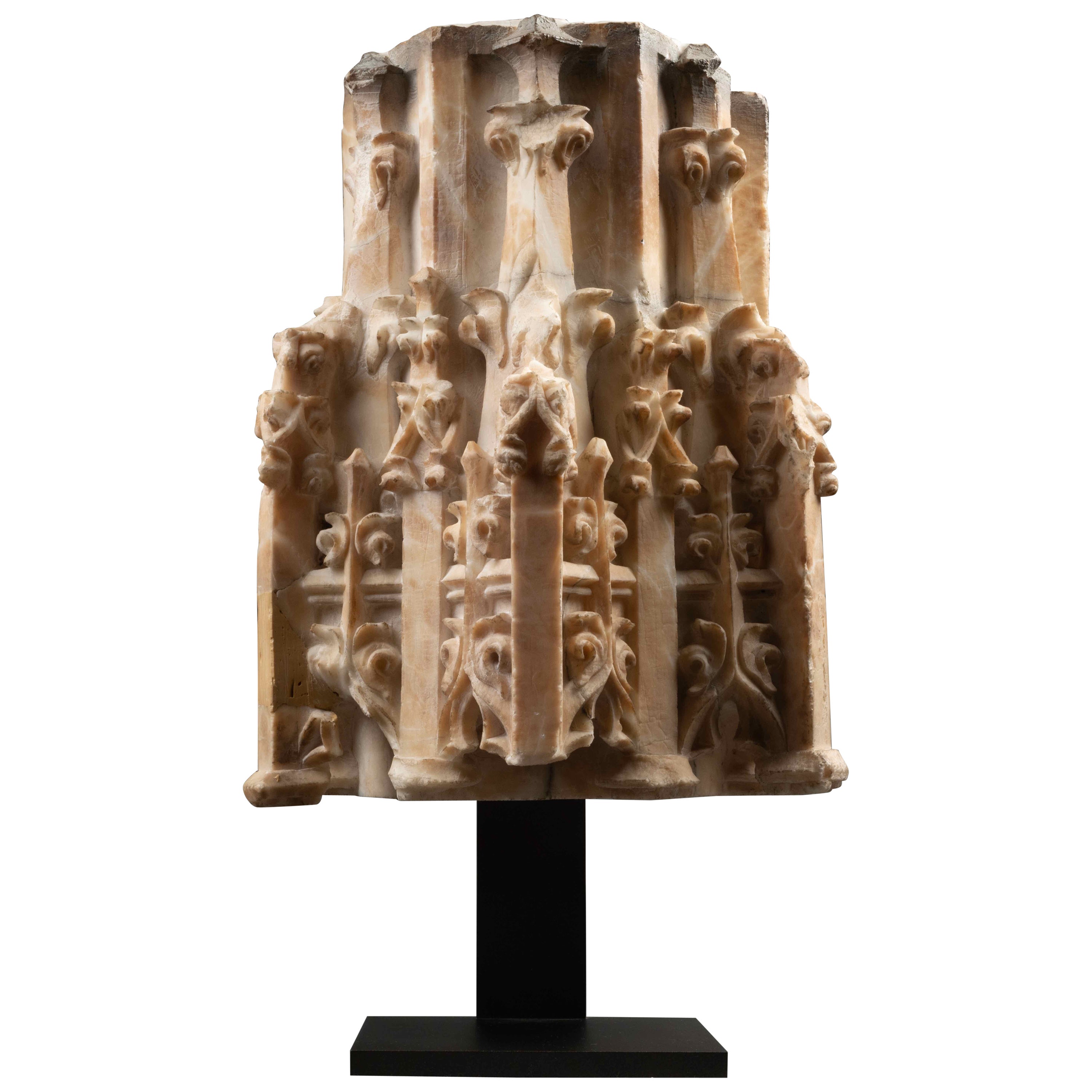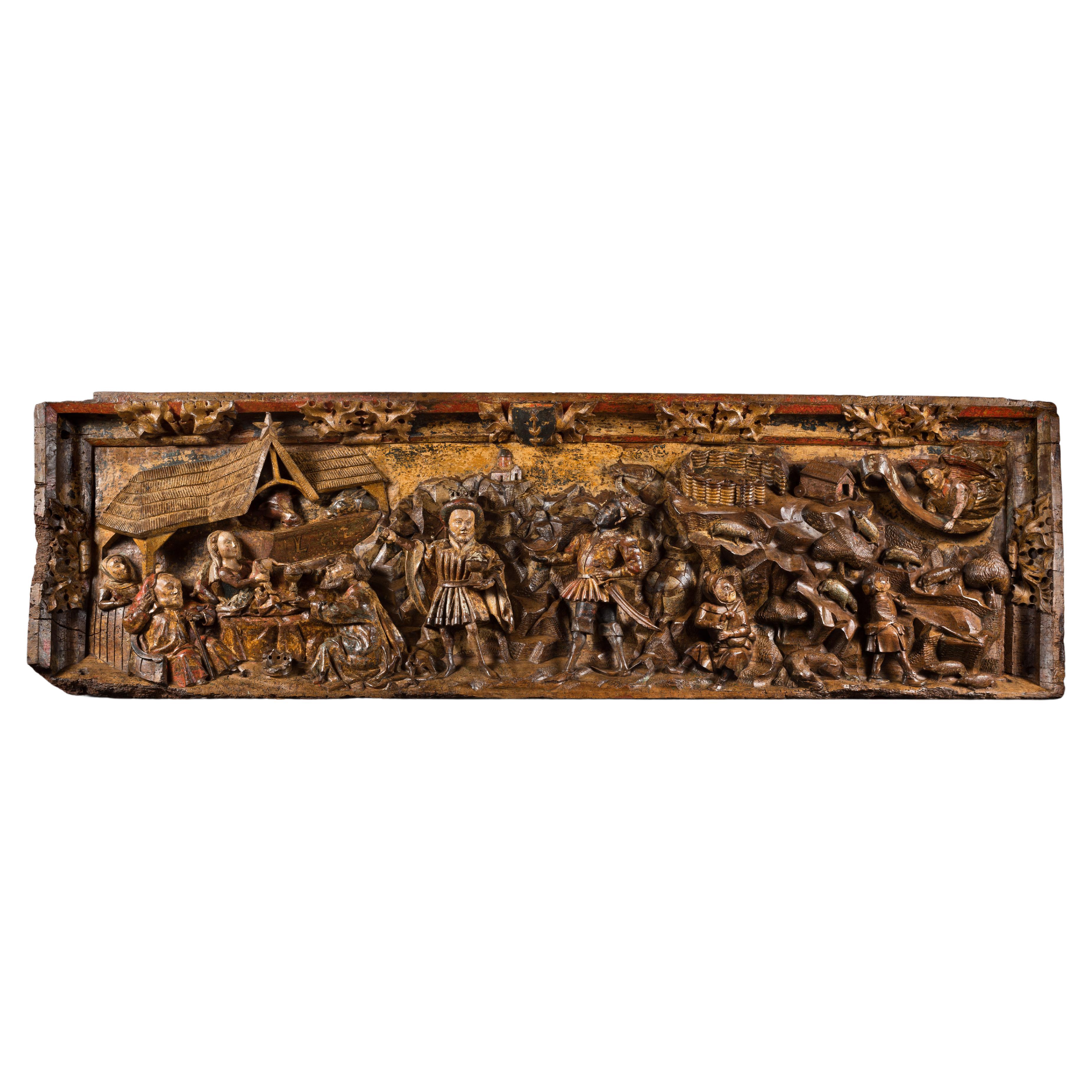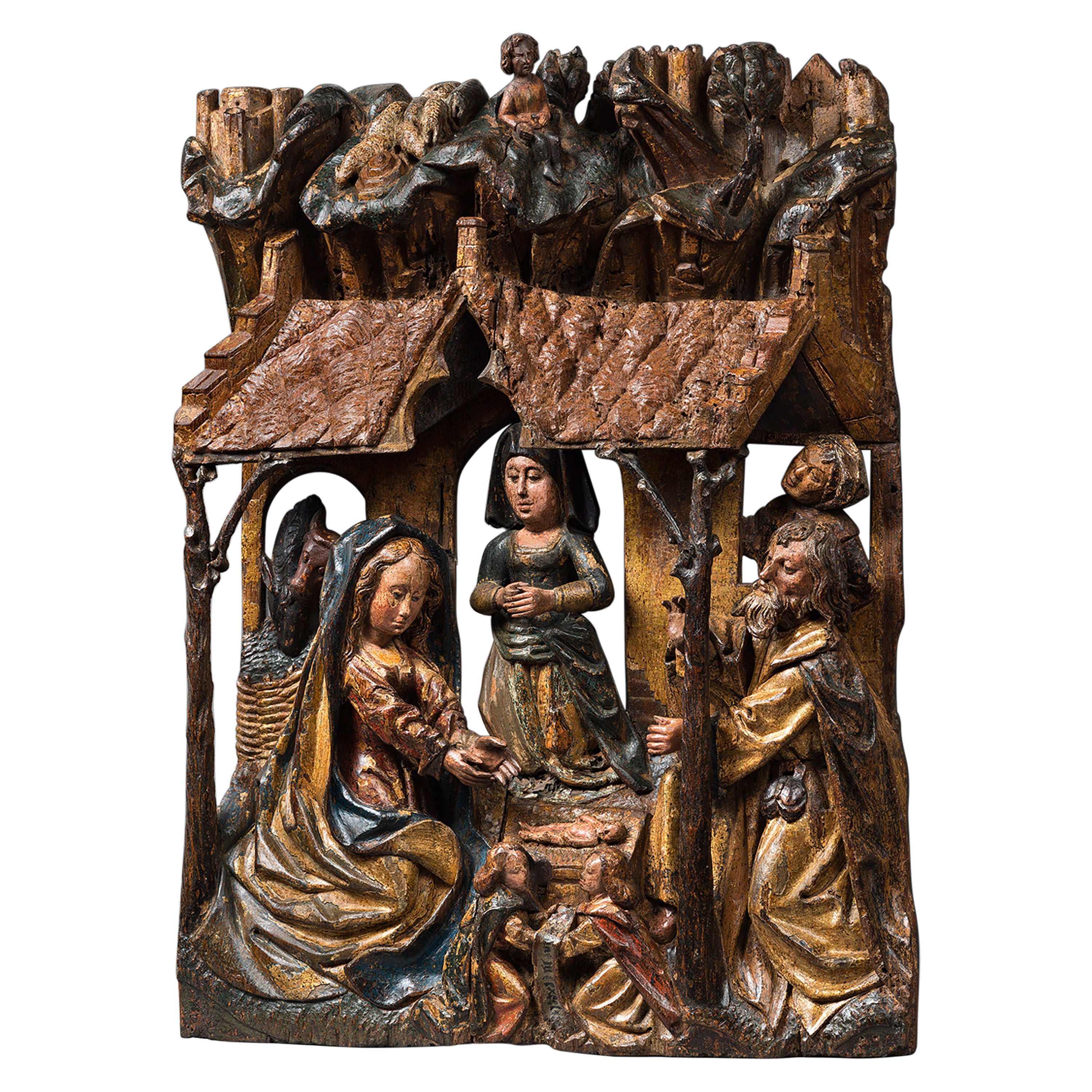Items Similar to Large Hexagonale Base of Pilaster in Burgundy Stone, Burgundy, 15th Century
Want more images or videos?
Request additional images or videos from the seller
1 of 6
Large Hexagonale Base of Pilaster in Burgundy Stone, Burgundy, 15th Century
About the Item
Large base of molded hexagonal pilaster in burgundy stone carved with vines, grapes and rosettes in high relief.
Burgundy, 15th century
28 x 63 x 30 cm
Provenance : collection Demotte
This very large pilaster base decorated with vines leaves and entangled stems, grapes and rosettes was carved during the 15th century in France, probably in Burgundy as is confirmed by the compact grained limestone, slightly pink, typical of the Burgundy region. The vines leaves and grapes in very high relief, almost tuttotondo, curent around the hexagonal base.
Medieval artists did not claim to be botanists, and therefore did not seek to restore a perfect physiognomy of plants. The inaccuracy of these representations gives free rein to the symbolic value, which accompanies the decorative one.
Therefor, the representation of the vine is not insignificant, if one refers to the biblical association of this plant with the figure of Christ and Eucharist : the grape gives the wine of eternal life, symbol of the blood of Christ.
The rose, also present at regular intervals in the present carved relief, symbolize the love and charity of the Virgin which is represented in the writings of Saint Bernard as "the rosa sine spina" or the rose without thorns.
But also, in medieval monumental sculpture, the plant decoration is exploited for their ornamental quality of leaves, stems, fruits or flowers: projecting veins, very cut out profiles, long rolled stems.
In the 13th and 14th century cathedrals, a decoration borrowed from the vegetal repertoire is found on all the sculpted or molded parts of the architecture, the slender lines of which it emphasizes and exalts.
This pilaster base comes from the collection of Georges Joseph Demotte (1877-1923) famous art dealer of Belgian origin specialized in Medieval French sculpture. Central figure of the international art market at the beginning of the 20th century, Demotte founded two sumptuous galleries in Paris and New York where he attracted important private collectors and institutions like the Metropolitan Museum of Art.
- Dimensions:Height: 11.03 in (28 cm)Width: 24.81 in (63 cm)Depth: 11.82 in (30 cm)
- Style:Gothic (Of the Period)
- Materials and Techniques:
- Place of Origin:
- Period:
- Date of Manufacture:15th Century
- Condition:Wear consistent with age and use.
- Seller Location:Bruxelles, BE
- Reference Number:1stDibs: LU6666230815932
About the Seller
5.0
Vetted Seller
These experienced sellers undergo a comprehensive evaluation by our team of in-house experts.
1stDibs seller since 2022
6 sales on 1stDibs
Typical response time: <1 hour
- ShippingRetrieving quote...Ships From: Bruxelles, Belgium
- Return PolicyA return for this item may be initiated within 3 days of delivery.
More From This SellerView All
- Gothic Stone Fragment Representing Vine Leaves, France, 15th CenturyLocated in Bruxelles, BEGothic architectural fragment representing vine leaves France, 15th century Sandstone H 21 x 21 x 17 cm mounted on a modern metal pe...Category
Antique 15th Century and Earlier French Gothic Architectural Elements
MaterialsLimestone
- Large Medieval carved frieze - France, 14th-15th centuryLocated in Bruxelles, BEGothic Limestone frieze decorated with curly foliage North of France, 14th-15th century 59,8 x 15,6x 22 cm This French Gothic limestone frieze, adorned with curling foliage, stands ...Category
Antique 15th Century and Earlier French Medieval Architectural Elements
MaterialsLimestone
- Gothic Canopy, France, 15th CenturyLocated in Bruxelles, BEGothic canopy France, 15th century Alabaster, some traces of polychromy 33 x 23 x 20 cm Provenance: - Private collection Genève, Switzerland ...Category
Antique 15th Century and Earlier French Gothic Figurative Sculptures
MaterialsAlabaster
- Carved Limestone Balustrade, North of France, First Half of the 15th CenturyLocated in Bruxelles, BECarved Limestone balustrade. In a modern metal frame. North of France, Ile de France or Normandy. End of the 14th century - first half of the 15th century. Measures: 90 x 62 x 8...Category
Antique 15th Century and Earlier French Medieval Architectural Elements
MaterialsLimestone
- Rare Romanesque Capital Representing Daniel in the Lion’s Den, 12th CenturyLocated in Bruxelles, BEEngaged Romanesque capital representing Daniel in the Lion’s den France, 12th century Limestone 38 x 29 x 18 cm Provenance : Private coll...Category
Antique 15th Century and Earlier French Medieval Architectural Elements
MaterialsLimestone
- Double Romanesque Capital, France, 13th CenturyLocated in Bruxelles, BEDouble romanesque capital decorated with two fantastic animals France, 13th century Measures: 26,5 x 38,5 x 14,5 cm. This rare double cap...Category
Antique 15th Century and Earlier French Medieval Architectural Elements
MaterialsStone
You May Also Like
- 15th Century Carved Wood Depicting Saint JamesLocated in Saint-Ouen, FRThe Saint depicted here is Saint James the Great. James is the brother of St. John the Evangelist. Nothing is known of his activities after the Ascension...Category
Antique 15th Century and Earlier French Gothic Figurative Sculptures
MaterialsOak
- Pair of 15th/16th Century Carved Oak SaintsLocated in Maidstone, GBA Pair of Late 15th or Early 16th Century Oak Saints carved in high relief and raised on polygonal bases. The female depicted standing in contrapose with low...Category
Antique 15th Century and Earlier European Gothic Figurative Sculptures
MaterialsOak
- 15th Century Burgundian Low-Relief Depicting Scenes of the NativityLocated in Saint-Ouen, FRProvenance : In the same private collection for several generations, Burgundy. The canonical Gospels describe briefly the episode of the Nativity. It comprises three parts : • The Preludes : the Journey to Bethlehem, the Census • The Nativity • The Announce to the Shepherds and the Adoration of the Magi Only the Gospel according to Matthew (2, 1-12) speaks about the Adoration of the Magi. Staying vague about their number it does say they brought the newborn gold, incense and myrrh. The apocryphals, the fathers of the Church and many other authors have filled in the gaps of the evangelic tale. The sobriety and symbolic of the story have been a huge inspiration to artists. Although one of the oldest depictions of the Adoration of the Magi dates from the 2nd century the theme became very popular in Christian art during the late 14th century. One of the reasons explaining this success is that it celebrates both the Virgin and Christ at the same time. This important walnut panel is carved in a strong relief and depicts the different steps of the story of Jesus’ birth. On the left, the donkey and ox that have accompanied Mary and Joseph from Bethlehem are depicted behind a trough. On the thatch roof appears the star that would guide the magi to the place of birth of Jesus. Mary is wearing a veil and is seating on a bed. She holds her baby at arm’s length to present him to the magi. Saint Joseph is by her side. The old man is holding a cane in his left hand while from the right hand he seems to uncover himself to greet the visitors. A woman assists to the scene. In front of the holy family the three magi stand behind one another to pay their homage to the newborn. The first magi has a pointed beard. He is already kneeling out of deference and has placed his crown to his feet. He gives the baby a hanap filled with gold coins. This is Melchior as the legend describes him with white hair and a long beard. Caspar, the second magi bears a cup of incense. He is looking at the third magi and with his right hand he points to the star that has guided them there. He has a short beard and wears crakow shoes, breeches and a wide sleeved doublet. Finally Balthazar, the elegant last magi proceeds proudly towards the holy family with his one hand on the saber’s hilt and the other holding a cup. He brings the divine child the myrrh. He probably just dismounted as the horse can be seen behind him. The scene is set in a very detailed and narrative decor. In the right part of the panel the shepherd receive the announce of Jesus’ birth. An angel comes down from heaven with a scroll bearing the good news in his hands. The herding dog sleeps peacefully while sheeps graze. At the top of the cliff we notice the gilded sheeps enclosure. The panel’s moulded frame is carved with a foliated decor. In it’s centre appears a coat-of-arms. It is the alliance of the three magi’s arms. Indeed as it was common for legendary figures the three of them received imaginaries coat-of-arms. Thus, on a field of azure stands a star for Melchior, a crescent for Caspar and a pennon for Balthazar. This high-relief panel is undeniably the work of a very skilled and imaginative artist. This key moment in the New Testament is transposed to a contemporary environment thanks to the figures’ clothing and the rural daily life scene. This way the universal dimension of the episode is highlighted allowing a better understanding for the contemporaries. The sculptor has represented the episodes of the Adoration of the Magi and the Announce to the Shepherd with great talent and numerous details giving life to a picturesque and narrative scene. The important traces of polychromy give those already very animated scenes a stronger pictorial power and a rich dynamism. Because of the picturesque and familiar realism so dear to the artists of the late Medieval era, of the didactic function of this type of panel as well as the quality of the sculpture this piece is an astounding example of Burgundian art of the 15th century. Literature Louis Réau, Iconographie de l’Art chrétien...Category
Antique 15th Century and Earlier French Gothic Figurative Sculptures
MaterialsWalnut
- Late 15th Century Polychrome Wood Carving Depicting the NativityLocated in Saint-Ouen, FRWhile the birth of Christ is briefly told in the Gospel of Luke (2, 7) it is in the apocryphal texts that we find most of the elements and details that have then inspired artists. As of the 14th century and even more of the 15th century the subject of the Adoration of the Child replaces in Western art the scene of the Birth, much favoured in Byzantine art. Instead of being depicted lying with the new-born swathed in the manger, the Virgin is now kneeling, her hands joined in prayer in front of the naked child. This change was probably hastened by the popularity of the visions of Saint Bridget of Sweden to whom the Virgin allegedly appeared to show how she had given birth to Jesus (Visions, VII, chap. 21). Sheltered by a thatch-roofed structure the Virgin is kneeling in front of the Child Jesus. She wears a magnificent red dress under a large gold cloak. Her curled blond hair is partially veiled. The newborn is lying on a straw mat. Joseph is depicted with a parted beard and stands opposite from the Virgin. He wears a tunic and a coat with a purse hanging from the belt. His costume reminds us of the long journey him and Mary have accomplished to reach Bethlehem. Two other women are present. One is looking through the stable’s window to observe the Holy Family while another one kneels in prayer in front of the divine child. The rich costume of the lady might indicate she is a donator. However they could also both represent the women who took part in the birth of Christ, Zelemi and Salome. Salome, incredulous did not believe in the virginal conception of Mary and she is represented far from the scene. The artist has depicted her with an expression of doubt on her face. Zelemi, on the contrary, is a believer. She is rewarded by a place of honour at the heart of the scene, close to Mary. To the left the donkey and ox that have accompanied Mary and Joseph to Bethlehem observe quietly the scene. On the foreground two angels hold a scroll reading an excerpt from the Gloria : “/Gloria/ in excelsis /Deo/.” One of the angels wears a blue cape while the other’s is red Those two colours are very significant as during Middle-Ages blue symbolises hope and red charity. Together they express the hope in redemption thanks to the advent of Christ and his sacrifice to come. Above the main scene, up a cliff, a small shepherd lets his herd of sheep graze amidst the trees. He is framed by two walled cities. This wood carving is the work of a very skilled and inventive artist. The piece bears witness to his exceptional talent. The realism of the scene is emphasised by the amount of details depicted. The refinement of the carving itself is highlighted by the well preserved polychromy. This key moment of the New Testament is set in a contemporary context thanks to the clothes of the characters and the scenes of rural life. The universal dimension of the scene is intensified while allowing contemporary viewers to grasp its meaning more easily. This care for details, the picturesque realism as well as the extraordinary rendition of the cloths suggest it was made by a Flemish artist during the late 15th century. This relief can be compared with the panel of the Nativity from the Saint-Vaast altarpiece made by Jacques Daret between 1433 and 1435, today in Madrid’s Thyssen-Bronemisza Museum. Literature Louis Réau, Iconographie de l’Art chrétien...Category
Antique 15th Century and Earlier Dutch Gothic Figurative Sculptures
MaterialsWood
- 15th Century Gothic Carved Oak Statue – Virgin of the AnnunciationLocated in Maidstone, GB15th Century Oak Wood Sculpture of the Virgin of the Annunciation beside a lectern supporting an opened book, the Virgin with both hands upraised ( one repaired) turning slightly to the left, her demeanour redolent of strength, compassion and benignity. Franco Flemish origin, circa 1480, 56 inches in height x 26 inches wide. Provenance : Lot 347, The Notable Art Collection, New York, April 1949, Joseph Brummer Collection Part 1Category
Antique 15th Century and Earlier Belgian Gothic Figurative Sculptures
MaterialsOak
- San Antonio Abad, Spanish School of the 15th Century '1440-1501'By Europa AntiquesLocated in Madrid, ESSan Antonio Abad, Castilian school of the 15th century (1440-1501) Carving in polychrome wood, measures: 45 x 15 cm good vintage conditions.Category
Antique 15th Century and Earlier Spanish Gothic Figurative Sculptures
MaterialsWood
Recently Viewed
View AllMore Ways To Browse
Architectural Base
Burgundy Furniture
Antique 15th Century Furniture
Burgundy And Black
Antique Burgundy
Medieval French
Architectural Mold
Stone Plant
Monumental Stone
Large Stone Garden
Gothic Architecture
15th Century French
Ornamental Elements
Carved Pilaster
15th Century Stone Sculpture
Stone Carved Roses
Burgundy Limestone
Carved York Stone





